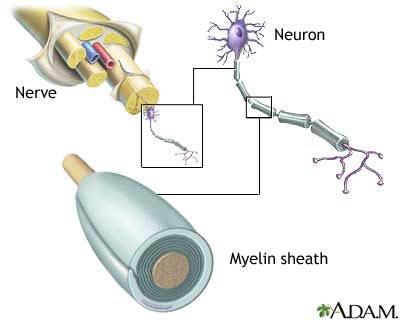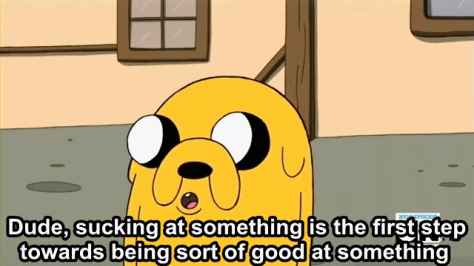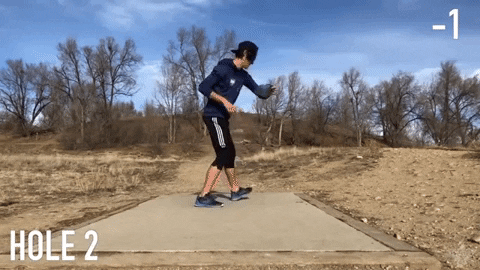Hey all, I've written another post on learning concepts, hope you enjoy!
Myelin, muscle memory and the acquisition of motor skills
On July 15th, 2018, Eagle McMahon shot 58-under par over four rounds to win his first major at the Konopiště Open. In a dominating performance, Eagle threw birdie or better on 80.56% of holes played, and threw back to back course records on the 11,000ft. Franz Ferdinand disc golf course.
On December 17, 2018, Eagle shot 2-under par during a single 18 hole round at Valmont Disc Park in Colorado. Valmont spans a respectful 3,894 ft. and there aren't many obstacles from tee to basket. Eagle was rated 1048 that day, but not with the hand he threw with, his left.
On hole two at Valmont, Eagle takes a practice swing and tips a bit off balance. Then his practice swings get shorter and shorter until he is standing over his plant foot, which he taps into the ground twice while pointing at it. He's noticeably slower and more deliberate with all of his throws that day.
Eagle has demonstrable elite level knowledge and skill in disc golf. But even he has to start at square one with muscle memory development to transfer that knowledge and skill to his left hand throw. Recent scientific studies have observed the physiological processes and changes that happen in our brains as we acquire skills. We can now literally see muscle memory develop and explain what is happening in Eagle's brain when he's working on these basic mechanics.
What is Myelin?
Every motor function we perform from driving a car, to brushing our teeth, to throwing a disc starts with neurons sending electrical signals down neural pathways (axons) throughout our brain. Those signals have to navigate a complex network of 85 billion neurons orchestrating numerous physiological functions, like breathing and blood circulation, to keep you alive and functioning.
Myelin is a fatty, white tissue that makes up nearly 50% of your brain, it is also known as white matter. It wraps around neural pathways, providing insulation for the signals fired from neurons.

For decades myelin was thought to be mostly passive biological infrastructure. In 2005 Fredrik Ullén, a professional pianist and professor of cognitive neuroscience, released a paper titled "Extensive Piano Practicing Has Regionally Specific Effects on White Matter Development". Fredrik and his team discovered that professional pianists had more myelin than non-musicians in certain neural pathways of their brains, and the more a musician practiced, the more myelinated those pathways became.
In his book, the Talent Code, Daniel Coyle summarizes the discovery into three simple facts:
Dr. Douglas Fields, neuroscientist and Chief of the Nervous System Development and Plasticity Section at the National Institutes of Health said:
Dr. George Bartzokis, professor of neurology at UCLA called it:
Further research has found:
- Neurons connected in a myelinated network can transmit signals 100 times faster and more efficiently than neurons that aren't connected.
- Myelin can modulate the speed of electrical impulses after they have fired, increasing precision in athletic actions which require exact timing of hundreds of thousands of impulses.
- Myelinated neural networks promote automaticity, the ability to do things without occupying the mind with the low-level details required, allowing it to become an automatic response pattern or habit. Automaticity is the unconscious competence stage of the four stages of competence concept previously discussed here: https://www.dgcoursereview.com/forums/showthread.php?t=138636
Incorporating the knowledge of myelin into your game
Understanding myelin is the difference between knowing that cars can drive and knowing how cars drive. Being aware of the internal mechanics of your body will help you diagnose and address issues quicker. When you are learning how to throw, you are reeducating your brain and the circuits it uses to interact with your muscles. It will take time, but you have the biological tools to do it.
As azplaya25 points out, you can use the knowledge of myelin to reevaluate other sports you've played for similar motions:
Personally, I was having trouble generating any power in my backhand throw from my hips and lower body. Remembering how to throw a long spin pass in rugby became a lightbulb moment. A long spin pass requires rotational movement and power from the lower body to throw the ball at distance and pace. Recognizing the similarities in the actions made it natural to get my hips involved in my backhand throw with much better balance and timing.
Myelination of the neural circuits you use to throw will happen over time, but progress in your skills won't always be linear. Learning to incorporate my hips into the backhand throw also had the side effect of throwing off the timing of my upper body and I did not have the same control. Integrating different swing components (or swing thoughts) that each have their own neural circuits will take time.
One of the implications of myelin is that you have to fire neural circuits poorly before you become proficient. Sucking is not optional, it's a prerequisite to competence. If your expectations on progress exceed the rate your myelin rewires, the learning process will be constantly disappointing. Your mental game will suffer and any practice will become less effective. Improvement requires focus on your mechanics, a sober analysis of your shots, and trust in the knowledge that firing neural circuits will make them more efficient over time.

Myelin, muscle memory and the acquisition of motor skills
On July 15th, 2018, Eagle McMahon shot 58-under par over four rounds to win his first major at the Konopiště Open. In a dominating performance, Eagle threw birdie or better on 80.56% of holes played, and threw back to back course records on the 11,000ft. Franz Ferdinand disc golf course.
On December 17, 2018, Eagle shot 2-under par during a single 18 hole round at Valmont Disc Park in Colorado. Valmont spans a respectful 3,894 ft. and there aren't many obstacles from tee to basket. Eagle was rated 1048 that day, but not with the hand he threw with, his left.
On hole two at Valmont, Eagle takes a practice swing and tips a bit off balance. Then his practice swings get shorter and shorter until he is standing over his plant foot, which he taps into the ground twice while pointing at it. He's noticeably slower and more deliberate with all of his throws that day.
Eagle has demonstrable elite level knowledge and skill in disc golf. But even he has to start at square one with muscle memory development to transfer that knowledge and skill to his left hand throw. Recent scientific studies have observed the physiological processes and changes that happen in our brains as we acquire skills. We can now literally see muscle memory develop and explain what is happening in Eagle's brain when he's working on these basic mechanics.
What is Myelin?
Every motor function we perform from driving a car, to brushing our teeth, to throwing a disc starts with neurons sending electrical signals down neural pathways (axons) throughout our brain. Those signals have to navigate a complex network of 85 billion neurons orchestrating numerous physiological functions, like breathing and blood circulation, to keep you alive and functioning.
Myelin is a fatty, white tissue that makes up nearly 50% of your brain, it is also known as white matter. It wraps around neural pathways, providing insulation for the signals fired from neurons.

For decades myelin was thought to be mostly passive biological infrastructure. In 2005 Fredrik Ullén, a professional pianist and professor of cognitive neuroscience, released a paper titled "Extensive Piano Practicing Has Regionally Specific Effects on White Matter Development". Fredrik and his team discovered that professional pianists had more myelin than non-musicians in certain neural pathways of their brains, and the more a musician practiced, the more myelinated those pathways became.
In his book, the Talent Code, Daniel Coyle summarizes the discovery into three simple facts:
- Every human movement, thought, or feeling is a precisely timed electrical signal traveling through a chain of neurons - a circuit of nerve fibers.
- Myelin is the insulation that wraps these nerve fibers and increases signal strength, speed, and accuracy.
- The more we fire a particular circuit, the more myelin wraps around and optimizes that circuit, and the stronger, faster, and more fluent our movements and thoughts become.
Dr. Douglas Fields, neuroscientist and Chief of the Nervous System Development and Plasticity Section at the National Institutes of Health said:
Dr. Fields said:There are a lot of factors that go into a talent like Tiger Woods and in the past if we would have looked in the brain to find the basis of that talent, we would have looked at neurons and synapses, and the surprise, now, is that with increasing talent, for example playing the piano, there are changes in myelin regions of the brain and this was never suspected in the past.
Dr. George Bartzokis, professor of neurology at UCLA called it:
Dr. Bartzokis said:Revolutionary. Myelin is the key to talking, learning skills, being human. What do good athletes do when they train? They send precise impulses along wires that give the signal to myelinate that wire. They end up, after all the training, with a super-duper wire, lots of bandwidth, a high speed T-3 line. That's what makes them different from the rest of us.
Further research has found:
- Neurons connected in a myelinated network can transmit signals 100 times faster and more efficiently than neurons that aren't connected.
- Myelin can modulate the speed of electrical impulses after they have fired, increasing precision in athletic actions which require exact timing of hundreds of thousands of impulses.
- Myelinated neural networks promote automaticity, the ability to do things without occupying the mind with the low-level details required, allowing it to become an automatic response pattern or habit. Automaticity is the unconscious competence stage of the four stages of competence concept previously discussed here: https://www.dgcoursereview.com/forums/showthread.php?t=138636
Incorporating the knowledge of myelin into your game
Understanding myelin is the difference between knowing that cars can drive and knowing how cars drive. Being aware of the internal mechanics of your body will help you diagnose and address issues quicker. When you are learning how to throw, you are reeducating your brain and the circuits it uses to interact with your muscles. It will take time, but you have the biological tools to do it.
As azplaya25 points out, you can use the knowledge of myelin to reevaluate other sports you've played for similar motions:
I think it's important to find other athletic moves that are already part of your muscle memory that you can translate to disc golf. For example, I've had the hardest time learning the x step or hop and how to stride down the tee pad in general. Sunday night I was playing basketball, guarding someone on the perimeter. I realized as I was moving laterally trying to stay in front of him that I was basically doing an effortless brinster hop without even thinking about it. I've tried so hard to figure out that hop and it's always felt so awkward...yet there I was, hopping laterally in perfect balance without even thinking about it.
Personally, I was having trouble generating any power in my backhand throw from my hips and lower body. Remembering how to throw a long spin pass in rugby became a lightbulb moment. A long spin pass requires rotational movement and power from the lower body to throw the ball at distance and pace. Recognizing the similarities in the actions made it natural to get my hips involved in my backhand throw with much better balance and timing.
Myelination of the neural circuits you use to throw will happen over time, but progress in your skills won't always be linear. Learning to incorporate my hips into the backhand throw also had the side effect of throwing off the timing of my upper body and I did not have the same control. Integrating different swing components (or swing thoughts) that each have their own neural circuits will take time.
One of the implications of myelin is that you have to fire neural circuits poorly before you become proficient. Sucking is not optional, it's a prerequisite to competence. If your expectations on progress exceed the rate your myelin rewires, the learning process will be constantly disappointing. Your mental game will suffer and any practice will become less effective. Improvement requires focus on your mechanics, a sober analysis of your shots, and trust in the knowledge that firing neural circuits will make them more efficient over time.

Eagle McMahon said:The problem is putting with my left hand, it feels so bad, it just feels like a newborn baby. But the cool thing about throwing lefty is it really helps me when I do clinics, or when I talk to new, up and coming players. It puts me in the beginners mindset, where I have to really emphasize my movements and make sure all my body mechanics are falling into place.
